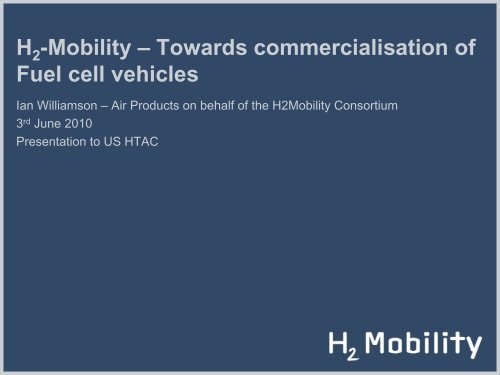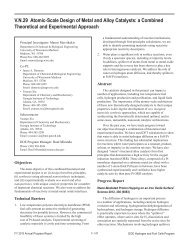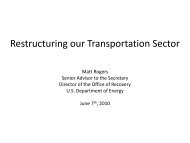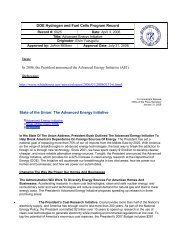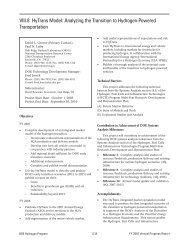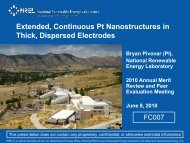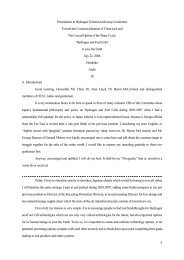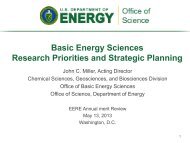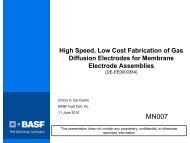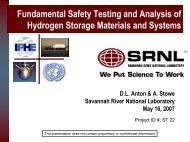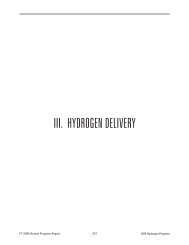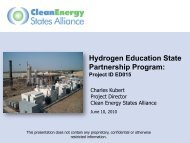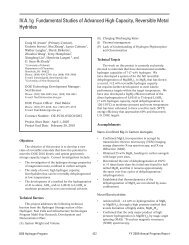Towards Cmmercialization of Fuel Cell Vehicles - DOE Hydrogen ...
Towards Cmmercialization of Fuel Cell Vehicles - DOE Hydrogen ...
Towards Cmmercialization of Fuel Cell Vehicles - DOE Hydrogen ...
Create successful ePaper yourself
Turn your PDF publications into a flip-book with our unique Google optimized e-Paper software.
H 2 -Mobility – <strong>Towards</strong> commercialisation <strong>of</strong><br />
<strong>Fuel</strong> cell vehicles<br />
Ian Williamson – Air Products on behalf <strong>of</strong> the H2Mobility Consortium<br />
3 rd June 2010<br />
Presentation to US HTAC
Objective <strong>of</strong> this meeting<br />
• To explain the H 2<br />
Mobility initiative as the centre piece <strong>of</strong> the commercialisation<br />
plan <strong>of</strong> hydrogen fuel cell vehicles in Europe
Agenda<br />
• Proposed plan<br />
• 1 st project: evaluation along the value chain<br />
• 2 nd project: H 2<br />
Mobility – Germany as a first market<br />
• 3 rd project: Planning a roll out across Europe<br />
• Next steps
<strong>Fuel</strong> cell vehicle commercialization plan<br />
Jan 2010 June 2010 Dec 2010<br />
Q2 2011?<br />
Q3 2011?<br />
Preparation<br />
1. Performance across<br />
the hydrogen & electric<br />
value chain<br />
2. H 2<br />
Mobility: Develop<br />
German FCV<br />
implementation plan<br />
Evaluation<br />
Preparation<br />
3. Formulate EU<br />
roll out scenario<br />
Process<br />
~6 months 9-12 months<br />
• Companies validate basic data<br />
on current and future cost and<br />
performance <strong>of</strong> BEVs, PHEVs,<br />
FCVs and ICEs by segment<br />
• Regular steering committees and<br />
workshops<br />
• Managed by McKinsey<br />
• Companies do the analysis<br />
for major parts <strong>of</strong> the work<br />
and jointly build business<br />
case<br />
• Chaired and managed by<br />
NOW, with help <strong>of</strong> McKinsey<br />
• Open to new comers<br />
4 - 6 months<br />
• Strong involvement MS and<br />
EU bodies (JTI)<br />
• Joint process <strong>of</strong> developing<br />
insights & recommendations<br />
• Led by consortium,<br />
facilitated by external<br />
consultant (public tender)<br />
Deliverable<br />
Stakeholders<br />
involved and roles<br />
• Fact based report comparing<br />
value chains <strong>of</strong> BEVs, PHEVs,<br />
FCVs and ICEs along value<br />
chain<br />
• 30 organisations involved<br />
• Car OEMs with FCVs, Evs,<br />
<strong>Hydrogen</strong> producers and<br />
distributors, Wind, Gas, Power<br />
companies, NGOs, and public<br />
entities<br />
• Business plan, incentive<br />
schemes, JV set up<br />
• 9 – 16 parties involved:<br />
• Car OEMs, Utility, Oil, Gas,<br />
Equipment<br />
• German government<br />
facilitates group<br />
= private funding = private + German funding = private + JTI funding<br />
• Report with H 2 business<br />
case for EU, EU roadmap,<br />
and funding requirements<br />
• 30+ parties involved:<br />
• Companies<br />
• Selected national<br />
governments, EC, JTI<br />
• NGOs, and public entities
Commercialisation plan principles<br />
• No obligation to join all three projects; companies can pick and choose based on<br />
their business interest<br />
• Participants can leave projects at any time, but without reimbursement <strong>of</strong><br />
(consulting) fees
Agenda<br />
• Proposed plan<br />
• 1 st project: evaluation along the value chain<br />
• 2 nd project: H 2<br />
Mobility – Germany as a first market<br />
• 3 rd project: Planning a roll out across Europe<br />
• Next steps
SOURCE: Request for Proposal. "Develop an objective and fact-based evaluation <strong>of</strong> the hydrogen and electric value chain"<br />
Deliverables: fact based evaluation comparing value<br />
chains <strong>of</strong> Plug ins, BEVs, FCVs and hybridized ICEs<br />
1<br />
• Comparison <strong>of</strong> FCVs and plug in hybrids<br />
on most important current and future<br />
customer features to electric vehicles and<br />
conventional hybridized vehicles (multiple<br />
dimensions and on timeline, segmentation)<br />
5<br />
• Cost for each production and distribution<br />
pathway now and in the future including<br />
"how-to approach“ and determination when<br />
distributed production will become<br />
competitive<br />
2<br />
• Costs for serial and mass production for<br />
reference FCV now and in the future –<br />
"how-to approach"<br />
6<br />
• Comparison <strong>of</strong> value add <strong>of</strong> FCVs to BEVs<br />
and hybrid ICEs and the macroeconomic<br />
impact to various EU regions in terms <strong>of</strong><br />
employment and job creation<br />
3<br />
• Technical challenges that have been<br />
overcome and need to be resolved for<br />
2015 mass production including synergies<br />
with electric vehicles<br />
7<br />
• Integrated view across the hydrogen value<br />
chain compared to electric value chain and<br />
advanced cycle ICE and high-level "case<br />
to society" for either Europe, US, Korea, or<br />
Japan<br />
4<br />
• Definition <strong>of</strong> main CO 2<br />
lean H 2<br />
production<br />
and phased distribution and dispensing<br />
method as well as explanation <strong>of</strong> it in factbased<br />
"technology for dummies" way<br />
8<br />
• Identification <strong>of</strong> cost-effective, creditable,<br />
and scalable EU funding mechanisms to<br />
deploy hydrogen infrastructure and rolling<br />
assets including FCVs and accelerate<br />
take-up and overall market transformation<br />
7
Coalition status<br />
Study participants Europe US Asia<br />
Car OEMs 4 2 4<br />
Electrolyser companies 2 2 -<br />
Gas companies 2 1 -<br />
Utilities 2 - -<br />
Oil companies 5 - -<br />
Other suppliers & equipment manufacturers 3 1 -<br />
NGOs 1 - -<br />
Government 2 - -<br />
Total 21 6 4 Σ = 31<br />
8
Agenda<br />
• Proposed plan<br />
• 1 st project: evaluation along the value chain<br />
• 2 nd project: H 2<br />
Mobility – Germany as a first market<br />
• 3 rd project: Planning a roll out across Europe<br />
• Next steps
Current hydrogen demonstration projects<br />
proving technical viability for end customer usage<br />
Clean Energy Partnership (CEP)<br />
• Since 2003<br />
• 40 cars and 14 buses in usage<br />
• 3 fuelling stations active in 2010<br />
• > 500,000 km driven &<br />
> 5,000 fuelings performed<br />
Demonstration projects show:<br />
• <strong>Fuel</strong> <strong>Cell</strong> cars ready for end customer<br />
usage (latest challenge<br />
“cold start ability” solved)<br />
• Production, supply and fueling <strong>of</strong><br />
hydrogen feasible and scalable<br />
10<br />
23.06.2010
“H 2 -Mobility” Initiative –<br />
Overcoming the Chicken and Egg Dilemma<br />
• Signing <strong>of</strong> Memorandum <strong>of</strong> Understanding for “H2 Mobility” Sept. 10th in Berlin<br />
• Nine key stakeholders from industry (OEM, oil, utility & industrial gas)<br />
and NOW as public-private-partnership<br />
• Intention to jointly build up hydrogen fueling infrastructure<br />
and establishing Germany as lead market<br />
11 Dr. Klaus Bonh<strong>of</strong>f | Titel der Präsentation<br />
23.06.2010
A Way Forward: The H2-Mobility Initiative<br />
• A strong Partnership <strong>of</strong> Motivated Stakeholders<br />
• Germany as a Pilot Market for Europe<br />
• Additional Partners Welcome<br />
Leading industrial companies to agree upon a built up plan<br />
for a nationwide infrastructure – NOW as independent chair<br />
Significant expansion <strong>of</strong> hydrogen fuelling stations network<br />
in key regions by the end <strong>of</strong> 2011<br />
Important milestone on the way to emission-free mobility<br />
Flanking Letter <strong>of</strong> Understanding on the Development and<br />
Market Introduction <strong>of</strong> <strong>Fuel</strong> <strong>Cell</strong> <strong>Vehicles</strong><br />
12 Dr. Klaus Bonh<strong>of</strong>f | Titel der Präsentation<br />
23.06.2010
Important Steps on the Way to a Commercialization<br />
<strong>of</strong> <strong>Fuel</strong> <strong>Cell</strong> <strong>Vehicles</strong> started in September 2009<br />
Commercialization FCVs<br />
Build-up H 2 -Infrastructure<br />
Letter <strong>of</strong> Understanding<br />
„Commitment to the development<br />
and market introduction<br />
<strong>of</strong> <strong>Fuel</strong> <strong>Cell</strong> vehicles“<br />
Memorandum <strong>of</strong> Understanding<br />
„H 2 -Mobility –<br />
Major companies sign up to<br />
hydrogen infrastructure built-up plan<br />
in Germany“<br />
13 Dr. Klaus Bonh<strong>of</strong>f | Titel der Präsentation<br />
23.06.2010
Common Commitment for Commercialization<br />
<strong>of</strong> <strong>Fuel</strong> <strong>Cell</strong> <strong>Vehicles</strong> until 2015<br />
Letter <strong>of</strong> Understanding signed in Sept. 2009<br />
for commercialization <strong>of</strong> fuel cell vehicles until 2015<br />
• The Letter <strong>of</strong> Understanding was signed by all relevant automotive<br />
manufacturers, which are engaged in the development <strong>of</strong> fuel cell technology.<br />
• From 2015 onwards a quite significant number <strong>of</strong> fuel cell vehicles could be<br />
commercialized. This number is aimed at a few hundred thousand vehicles<br />
over life cycle on a worldwide basis.<br />
• In order to ensure a successful market introduction <strong>of</strong> fuel cell vehicles, this<br />
market has to be aligned with the build-up <strong>of</strong> the necessary hydrogen<br />
infrastructure by 2015.<br />
• The network should be built-up from metropolitan areas via corridors into<br />
area-wide coverage.<br />
14 Dr. Klaus Bonh<strong>of</strong>f | Titel der Präsentation<br />
23.06.2010
Organisation <strong>of</strong> the H 2 -Mobility Consortium<br />
• Two successive Phases defined<br />
• Phase 1: 2009 – 2011<br />
• Technico-economical evaluation <strong>of</strong> the feasibility to deploy a<br />
network <strong>of</strong> HFS alongside the expected deployment <strong>of</strong> FCVs in<br />
Germany by 2015 (2009 – 2010)<br />
• Definition <strong>of</strong> the future Consortium Agreement Contract / Partners<br />
negociation phase (2011)<br />
• Deployment <strong>of</strong> new HFS supported by the German Administration<br />
(Konjunkturpaket II subsidy scheme)<br />
• Phase 2: 2011+<br />
• Implementation <strong>of</strong> the Business Plan defined in Phase 1<br />
through the agreed definitive agreement between partners<br />
15 Dr. Klaus Bonh<strong>of</strong>f | Titel der Präsentation<br />
23.06.2010
Organisation <strong>of</strong> the H 2 -Mobility Consortium<br />
WGs set up to achieve Phase 1 – McKinsey facilitator – NOW chair<br />
• Customer Value Proposition, H 2<br />
-Production & Supply, <strong>Hydrogen</strong> <strong>Fuel</strong> Station<br />
Technology Roadmap, Incentives Schemes, Economic Modelling (including<br />
network planning), Future Consortium and three support WGs<br />
WG<br />
CVP<br />
FCV Price / Car<br />
Introduction<br />
Scenarios<br />
Clean<br />
room<br />
WG<br />
HFS Technology<br />
Roadmap<br />
Station Concept /<br />
Module Cost<br />
Clean<br />
room<br />
Verified<br />
and<br />
Neutralized<br />
Data<br />
Economic<br />
Model<br />
WG<br />
H 2<br />
-Production<br />
H 2<br />
-Cost<br />
Clean<br />
room<br />
16 Dr. Klaus Bonh<strong>of</strong>f | Titel der Präsentation<br />
23.06.2010
Typical approach for build-up <strong>of</strong> hydrogen infrastructure<br />
in Germany (Schematic)<br />
2013 2015 2017<br />
2013 2015 2017<br />
159 500<br />
159 500 1.000<br />
<strong>Fuel</strong>ing stations<br />
Large<br />
medium<br />
small<br />
17 Dr. Klaus Bonh<strong>of</strong>f | Titel der Präsentation<br />
23.06.2010
Agenda<br />
• Proposed plan<br />
• 1 st project: evaluation along the value chain<br />
• 2 nd project: H 2<br />
Mobility – Germany as a first market<br />
• 3 rd project: Planning a roll out across Europe<br />
• Next steps
Planning an EU roll out<br />
• Study will be made “conditional” to successful outcome <strong>of</strong> H2 Mobility<br />
• Study will be implemented by the <strong>Fuel</strong> <strong>Cell</strong> and <strong>Hydrogen</strong> JTI with participation<br />
<strong>of</strong> coalition <strong>of</strong> interested companies and governments
Overview <strong>of</strong> objectives <strong>of</strong> “planning an roll out across<br />
Europe”<br />
Main elements<br />
Overall objective<br />
Stimulate<br />
implementation <strong>of</strong><br />
and support for<br />
hydrogen based<br />
transport systems<br />
by providing an<br />
inspiring vision<br />
and concrete plan<br />
on how the rollout<br />
<strong>of</strong> a hydrogen<br />
value chain across<br />
Europe could be<br />
organized<br />
• Overview <strong>of</strong> economic feasibility, benefits and obstacles <strong>of</strong><br />
<strong>Hydrogen</strong> roll‐out – summarizing existing knowledge<br />
• Scenario <strong>of</strong> European green H 2 production and infrastructure rollout<br />
starting from planned and existing (clean ‐ CCS) production<br />
and pipelines<br />
• Plausible scenarios for hydrogen FCV penetration across Europe<br />
including resulting estimated cost, environmental and economic<br />
impact<br />
• Development <strong>of</strong> a vision on the future role <strong>of</strong> <strong>Hydrogen</strong> in Europe<br />
that is shared across major stakeholders<br />
• Overview <strong>of</strong> potential incentive mechanism to stimulate early<br />
adoption and reward first movers based on German experiences<br />
• Concrete proposals on how regulatory and governmental support<br />
could be organized most effectively (required regulation,<br />
subsidies, and methodology)<br />
• Outlook for stationary FCs across Europe and synergies with<br />
automotive hydrogen value chain (no detailed scenarios)<br />
• High level view on global potential <strong>of</strong> hydrogen FCV and<br />
implications for Europe<br />
Source: European <strong>Fuel</strong> <strong>Cell</strong> and <strong>Hydrogen</strong> Joint Undertaking<br />
20
Source: European <strong>Fuel</strong> <strong>Cell</strong> and <strong>Hydrogen</strong> Joint Undertaking<br />
Overview <strong>of</strong> end-products and communication form per<br />
audience<br />
Main End‐Products<br />
General<br />
public<br />
EU<br />
National<br />
governments<br />
Coalition<br />
members<br />
1. 1 A vision and roll‐out plan for the future <strong>of</strong><br />
hydrogen transport in Europe, including:<br />
• Recap performance versus alternatives<br />
• <strong>Hydrogen</strong> roll‐out scenarios, incl.<br />
infrastructure and transport mix<br />
• Overview <strong>of</strong> long term impact<br />
(environment, economic)<br />
• High level action plan for Europe<br />
• Potential for other applications and regions<br />
• High‐end power‐point presentations (for press event)<br />
• Written vertical report<br />
• Detailed<br />
model<br />
assumptions<br />
and<br />
data<br />
2. 2 Overview and assessment <strong>of</strong> various support<br />
measures available for the EU to support<br />
<strong>Hydrogen</strong> roll‐out (including funding needs)<br />
• Detailed powerpoint presentation for<br />
group discussions<br />
3. 3 Overview <strong>of</strong> various potential regional rollout<br />
models with recommendations linked to<br />
archetype <strong>of</strong> environments<br />
• Powerpoint presentation<br />
for regional stakeholders<br />
Communication form per audiences / stakeholders
Elements <strong>of</strong> a successful outcome<br />
• A realistic and appealing vision on the potential role <strong>of</strong> <strong>Hydrogen</strong><br />
towards 2050<br />
• A realistic and easy to communicate hydrogen FCV roll‐out plan for<br />
Europe<br />
• A set <strong>of</strong> very concrete recommendations on regulation and financial<br />
incentives that can be adopted by European, national and regional<br />
governmental institutions<br />
• Buy in from European, national and regional governments and from<br />
companies involved in hydrogen value chain<br />
• Regional implications based on standardized (‘archetype')<br />
characteristics which can be used by local stakeholders to develop<br />
their own view and strategy on <strong>Hydrogen</strong> roll‐out<br />
Source: European <strong>Fuel</strong> <strong>Cell</strong> and <strong>Hydrogen</strong> Joint Undertaking<br />
22
Thank you very much for your attention


